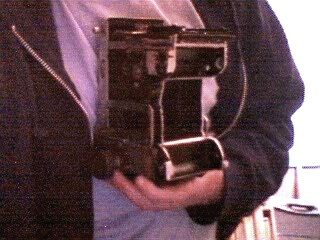Mamiya C33 mounted onto a Polaroid 240 body. Photo credit: Wes Almond
This modification required all of the internal gears and mechanisms to be stripped from the camera. This includes the double-exposure prevention, parrallax correction, exposure counter, film winder, automatic shutter cocking mechanism, interchangible lens lock and light baffle. All automatic features of the camera are thus LOST, and lenses can no longer be changed in the middle of a shoot without using a changing bag. Over 7mm of aluminum had to be cut from the back, and filed until it allowed for the appropriate infinity focus of the lens.
Following that, more material had to be cut from the interior to allow the image to project to fill the packfilm format. The backs of the focusing rails had to the filed down to allow for them to return to infinity. After all of this work, with aluminum dust filling the bellows and sticking to the grease in the rails I had to further break down the camera to clean the aluminum dust out of everything. After testing and checking infinity and close focus to the veiwfinder I built a metal light baffle inside of the camera to make it light-tight, as it no longer actually had sides! Heres a photo of the stripped and carved Mamiya:

After I was done with the Mamiya I had to completely strip and ruin the Polaroid camera. The first one I tried on was a plastic one and I broke the plastic right at the opening to the film door where the rollers mount. Then I got the aluminum bodied 240 instead. These things are VERY difficult to dissasemble as Polaroid used rivets instead of screws. Many of the parts break easily or are made of unbreakable steel and its very difficult to strip it completely down without breaking the body. I had to drill holes through both bodies AND the metal covers of the Mamiya to mount the bolts which hold it all together. It was not a precision job as I do not have the appropriate tools. I feared at any moment I was going to saw off a finger or break a peice off of the body that would cause the whole project to be useless. One really needs access to a milling machine and a drill press and other large precision machine tools to really do this conversion. Unless you are proficient in camera repair, using hand tools and machine tools, and abstract mechanical thinking, I DO NOT reccomend this conversion. It is 100% irreversible and possibly destroys 2 great classic cameras in one shot. The Mamiya I used was broken, it would not focus to inifnity or advance properly and was rather beatup physically, someone else had attempted repairs and could not fix it. If yours is usuable... DONT CUT IT UP.... Its like cutting the roof off of your Jaguar with a chainsaw because you think you might like more sun.
The whole process is very difficult and took 2 weeks of long hours to do. If you are interested in a TLR based polaroid conversion I would recommend a much cheaper and easier to cut camera than the Mamiya. I am interested in trying this converion with a different camera if someone is willing to provide both cameras (or polaroid back) and some cash in exchange for all the hard work! Any Packfilm, 600 camera, or Packfilm back would probably work for this conversion, and a wide range of TLR cameras would probably work. I DO NOT recommend trying this with your grandfather's Rollie. Contact me if you are interested in discussing conversions:
»
link
There is a more resonable conversion possible if you do not require infinity focus.... it makes a 6x6 square on the polaroid. This person used a Mamiya C330 with the removable back and taped a Polaroid back to it. Then he adjusted his ground glass to match the focus. Its reversible and could probably be done in a day:
»
link